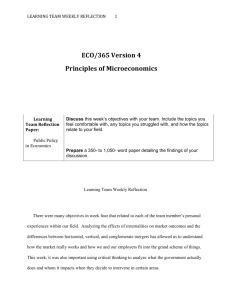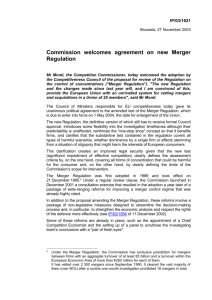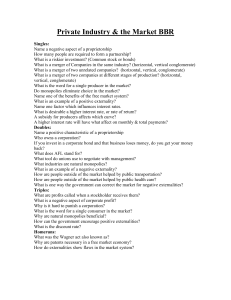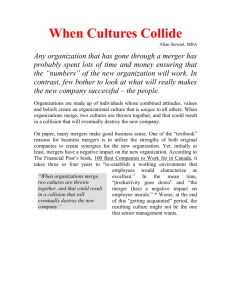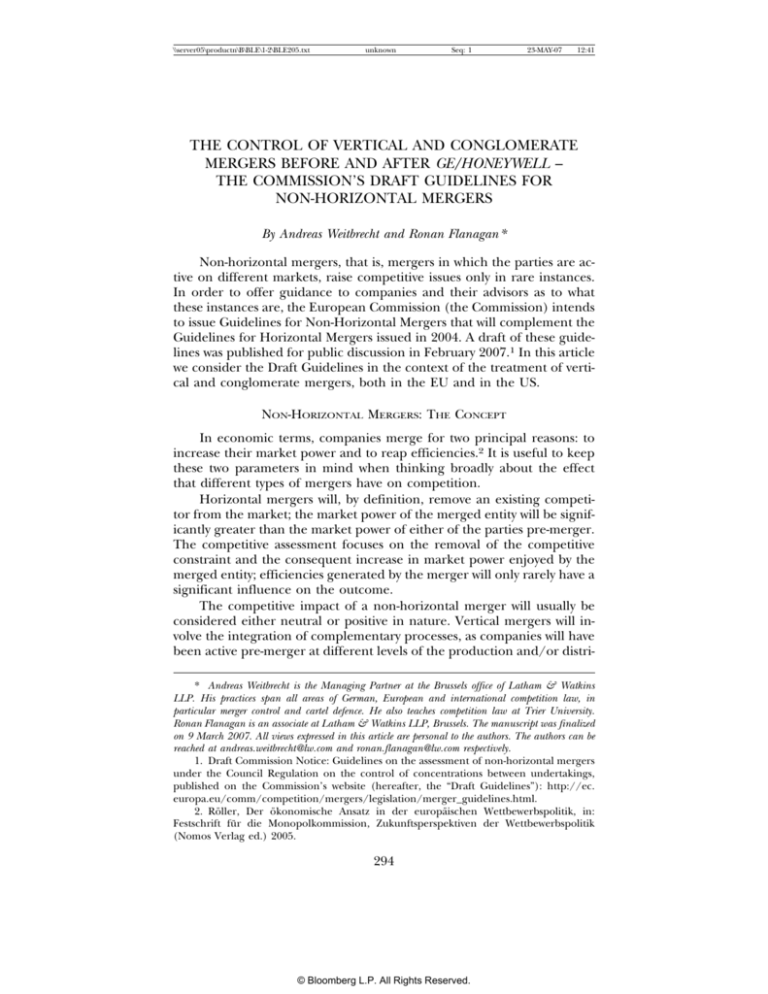
\\server05\productn\B\BLE\1-2\BLE205.txt
unknown
Seq: 1
23-MAY-07
12:41
THE CONTROL OF VERTICAL AND CONGLOMERATE
MERGERS BEFORE AND AFTER GE/HONEYWELL –
THE COMMISSION’S DRAFT GUIDELINES FOR
NON-HORIZONTAL MERGERS
By Andreas Weitbrecht and Ronan Flanagan*
Non-horizontal mergers, that is, mergers in which the parties are active on different markets, raise competitive issues only in rare instances.
In order to offer guidance to companies and their advisors as to what
these instances are, the European Commission (the Commission) intends
to issue Guidelines for Non-Horizontal Mergers that will complement the
Guidelines for Horizontal Mergers issued in 2004. A draft of these guidelines was published for public discussion in February 2007.1 In this article
we consider the Draft Guidelines in the context of the treatment of vertical and conglomerate mergers, both in the EU and in the US.
NON-HORIZONTAL MERGERS: THE CONCEPT
In economic terms, companies merge for two principal reasons: to
increase their market power and to reap efficiencies.2 It is useful to keep
these two parameters in mind when thinking broadly about the effect
that different types of mergers have on competition.
Horizontal mergers will, by definition, remove an existing competitor from the market; the market power of the merged entity will be significantly greater than the market power of either of the parties pre-merger.
The competitive assessment focuses on the removal of the competitive
constraint and the consequent increase in market power enjoyed by the
merged entity; efficiencies generated by the merger will only rarely have a
significant influence on the outcome.
The competitive impact of a non-horizontal merger will usually be
considered either neutral or positive in nature. Vertical mergers will involve the integration of complementary processes, as companies will have
been active pre-merger at different levels of the production and/or distri* Andreas Weitbrecht is the Managing Partner at the Brussels office of Latham & Watkins
LLP. His practices span all areas of German, European and international competition law, in
particular merger control and cartel defence. He also teaches competition law at Trier University.
Ronan Flanagan is an associate at Latham & Watkins LLP, Brussels. The manuscript was finalized
on 9 March 2007. All views expressed in this article are personal to the authors. The authors can be
reached at andreas.weitbrecht@lw.com and ronan.flanagan@lw.com respectively.
1. Draft Commission Notice: Guidelines on the assessment of non-horizontal mergers
under the Council Regulation on the control of concentrations between undertakings,
published on the Commission’s website (hereafter, the “Draft Guidelines”): http://ec.
europa.eu/comm/competition/mergers/legislation/merger_guidelines.html.
2. Röller, Der ökonomische Ansatz in der europäischen Wettbewerbspolitik, in:
Festschrift für die Monopolkommission, Zukunftsperspektiven der Wettbewerbspolitik
(Nomos Verlag ed.) 2005.
294
© Bloomberg L.P. All Rights Reserved.
\\server05\productn\B\BLE\1-2\BLE205.txt
unknown
Seq: 2
23-MAY-07
2007] CONTROL OF VERTICAL AND CONGLOMERATE MERGERS
12:41
295
bution chain. Thus, the merger will often generate increased productive
and pricing efficiencies without leading to an increase in market power.
A conglomerate merger will involve entities trading in different, but often
closely related markets, without a vertical relationship. As a result, the
chances of a detrimental competitive impact are even more remote, while
efficiencies flowing from so-called “portfolio” or “range” effects (i.e., the
ability to offer a broad line of products to the same customer group) will
often be generated.
THE EVOLUTION
IN THE
ANALYSIS OF VERTICAL
MERGERS IN THE US
AND
CONGLOMERATE
It is instructive to view the current economic analysis of vertical and
conglomerate mergers in the EU against the historical background of the
treatment of such mergers in the US.3 Until the 1970s, merger control in
the US was considered to pursue not so much the narrow goal of consumer welfare in economic terms as it is considered today; instead,
merger control was thought to be primarily designed to keep “big business” from expanding further and from penetrating markets historically
in hands of local operators.
Brown Shoe
In 1962, in Brown Shoe, the US Supreme Court affirmed the prohibition by the District Court of a merger between two vertically integrated
shoe manufacturers that would have resulted in market shares of little
more than ten percent in some markets both on horizontal and vertical
grounds.4 In support of the prohibition on account of the vertical aspects, the Court highlighted the fact that due to the vertical integration
of the two companies, the wholesalers of shoes would be losing business
and the risk would be that local shoe stores would be pushed aside by the
vertically integrated firm.5
Procter & Gamble
As to conglomerate mergers, the Procter & Gamble Supreme Court
judgment of 1967 illustrates the thinking at the time.6 The acquired firm,
Clorox, was the leading manufacturer in the heavily concentrated household bleach market with a national market share of forty-nine percent.
Procter & Gamble (P&G), the acquirer, was at the time a diversified manufacturer of other household products, primarily soaps and detergents;
P&G, however, did not produce bleach.
3. EU merger control only began in 1990 with the coming into force of Regulation
4064/89, the first merger control regulation, and therefore has no relevant experience to
draw upon prior to 1990.
4. Brown Shoe Co. v. United States, 370 US 294 (1962).
5. Id. at 333.
6. FTC v. Procter & Gamble Co., 386 US 568 (1967).
\\server05\productn\B\BLE\1-2\BLE205.txt
296
unknown
Seq: 3
BLOOMBERG EUROPEAN BUSINESS LAW JOURNAL
23-MAY-07
12:41
[Vol. 1:294
The Supreme Court endorsed the view of the FTC that the acquisition might substantially lessen competition in the bleach market, not only
because it would eliminate P&G as a potential entrant, but also because
the presence of P&G might deter new entrants which would be more
reluctant to face the giant P&G than the smaller Clorox.
1982 Merger Guidelines
Over much of the course of the 1970s this analysis was amply
criticised by academics. In particular, the Chicago School emphasised
that antitrust and competition law should exclusively pursue the goal of
allocative efficiency serving consumer welfare. By 1982 the Department of
Justice had introduced new merger guidelines7 suggesting only an extremely limited degree of intervention for vertical and conglomerate
mergers, on the basis that such mergers would primarily generate efficiencies to the ultimate benefit of consumers.
EU COMMISSION PRACTICE
Under the EU Merger Control Regulation the Commission has considered numerous vertical and a number of conglomerate cases. The
practice of the Commission can be summarized as follows:
Vertical Mergers
In its consideration of vertical effects, the Commission has been wary
of the possibility of foreclosing markets to third parties. This concern has
arisen in several cases in the telecommunications and media sectors. In
Nordic Satellite Distribution,8 the Commission prohibited the proposed
joint venture between Tele Denmark, Norsk Telecom and Kinnevik that
would have created an integrated market player active on several levels in
broadcast media, ranging from the production of television programmes
to the retailing of television sets. Similarly, in sectors where vital technology is developing at pace, the Commission has proved unwilling to permit
the position of “gatekeeper” to a vertically integrated company controlling both technology and content. This point may be usefully illustrated
through the case of AOL/Time Warner 9 in which the Commission was concerned that the merger of a major media and entertainment company
with a pan-European Internet provider could lead to unacceptable “gatekeeper” power in the fast-developing online music sector. This concern
7. U.S. Department of Justice, Merger Guidelines (1982), reprinted in 4 Trade Reg.
Rep. (CCH) 13, 102.
8. Case IV/M.490, Nordic Satellite Distribution, 19 July 1995.
9. Case Comp/M.1845, AOL/Time Warner, 11 October 2000. See also Case IV/M.469,
MSG Media Service, 9 November 1994; Case IV/M. 993, Bertelsmann/Kirch/Premiere, 27 May
1998; Case IV/M.1027, Deutsche Telekom/BetaResearch, 27 May 1998.
\\server05\productn\B\BLE\1-2\BLE205.txt
unknown
Seq: 4
23-MAY-07
2007] CONTROL OF VERTICAL AND CONGLOMERATE MERGERS
12:41
297
was eventually dealt with by way of commitments offered by the merging
parties and the merger was approved.10
Vertical effects have also led to significant hurdles for proposed
mergers in the energy sector.11 In the case of ENI/EDP/GDP,12 the Commission prohibited the proposed acquisition of joint control over GDP
(the incumbent gas operator in Portugal) by EDP (the incumbent electricity operator in Portugal) and ENI (an Italian energy company). Based
on the importance of gas as an input in the generation of electricity, the
Commission was concerned that the integration of the dominant gas and
electricity operators in Portugal would give rise to foreclosure effects both
on the gas and electricity markets. Various remedies offered by the parties proved insufficient to assuage the Commission’s concerns and the
prohibition was ultimately upheld on appeal to the European Court of
First Instance (CFI).13
Conglomerate Mergers
The Commission has intervened in conglomerate cases in rare instances. In Coca Cola/Carlsberg 14 the Commission considered that the
breadth of the beverage portfolio of the combined entity would result in
greater market power and economies of scale – clear efficiencies stood to
be gained but in the light of a pre-existing dominant position, this was
not helpful under the “efficiency offence” doctrine. As a result, the Commission extracted as a remedy the divestiture of the merged firm’s interest in a carbonated soft drinks bottling company as well as its interest in
the third largest Cola brand in Denmark.
In Guinness/Grand Metropolitan 15 the Commission required the
merged firm to end an existing distribution agreement for Bacardi Rum
in Greece on the grounds that a wide portfolio of leading brands would
give the merged firm the possibility of bundling sales and increasing the
sales volume of one category by tying it to the sale of another category.
Placing distribution of the Bacardi brand in different hands remedied
that perceived problem.
EU COURT CASES
Where the Commission has primarily or exclusively relied on conglomerate effects to prohibit mergers, its decisions have been appealed
and in both cases the Commission’s analysis has been severely criticised
by the courts.
10. See also Case Comp/M.3083, General Electric/Instrumentarium, 2 September 2003.
11. For an overview of recent Commission decisions in the energy sector, see
Weitbrecht, “EU Merger Control in 206 – the Year in Review”, [2007] ECLR 125.
12. Case Comp/M.3440, ENI/EDP/GDP, 9 December 2004.
13. Case T-87/05, EDP – Energias de Portugal SA v. Commission [2005] CMLR 4,
judgment of 21 September 2005.
14. Case IV/M.833, Coca Cola/Carlsberg, 11 September 1997.
15. Case IV/M.938, Guinness/Grand Metropolitan, 15 October 1997.
\\server05\productn\B\BLE\1-2\BLE205.txt
298
unknown
Seq: 5
BLOOMBERG EUROPEAN BUSINESS LAW JOURNAL
23-MAY-07
12:41
[Vol. 1:294
Tetra Laval/Sidel
In Tetra Laval/Sidel 16 the Commission prohibited the acquisition by
Tetra Laval, the dominant player in carton packaging (Tetra Pak), of
Sidel, the leading, but not dominant, manufacturer of machines that are
used to blow PET bottles. Carton packaging is used primarily for milk and
juices, whereas PET bottles are used for carbonated soft drinks and mineral water. The Commission considered that for certain sensitive products
that are currently packaged in cartons, PET bottles would over time become a technically and commercially viable alternative. Given that the
same groups of customers (bottlers of so-called sensitive products) would
then be able to choose between carton packaging and PET bottles, the
Commission reasoned that Tetra Laval would “leverage” its dominant position in carton packaging into the market for the machines used to blow
PET bottles. This complicated chain of events would then lead to Sidel
attaining a dominant position in the market for these machines. The CFI
rejected this analysis as too speculative and the Court of Justice affirmed
the CFI’s judgment.17
GE/Honeywell
In the celebrated case of General Electric/Honeywell,18 the Commission’s prohibition decision19 was severely criticised as far as the analysis of
vertical and conglomerate relationships was concerned. However, the CFI
did not annul the prohibition decision as the Court agreed with the Commission’s analysis of the horizontal effects on the markets of engines for
large regional jets and corporate jets as well as small marine gas turbines.
GE and Honeywell operate on numerous product markets in avionics and
non-avionics products for aircraft and Honeywell in particular had a leading position in most of the avionics markets and a very strong presence in
almost all non-avionics markets.20
Vertical-Conglomerate Effects 21
The Commission had considered that GECAS, the aircraft financing
arm of GE, would in the future specify Honeywell equipment in its air16. Case Comp/M.2416, Tetra Laval/Sidel, 30 October 2001.
17. Cases T-5/02, Tetra Laval v. Commission (Tetra Laval I), [2002] ECR II-4381,
judgment of 25 October 2002; and C-12/03 P, Commission v. Tetra Laval (Tetra Laval II),
[2005] ECR I-987, judgment of 15 February 2005.
18. Case T-210/01, General Electric v. Commission, [2006] 4 CMLR 14, judgment of 14
December 2005. For a summary and discussion of the case see Howarth, “The Court of
First Instance in GE/Honeywell”, [2006] ECLR 485.
19. Case Comp/M.2220, General Electric/Honeywell, 3 July 2001.
20. Avionics refers to equipment on an aircraft that is used for flying the aircraft
whereas non-avionics equipment refers to other aircraft equipment.
21. The Court also rejected the Commission’s purely vertical concerns as they were
based on a pure refusal to deal theory and the Commission had failed to take into account
the unlawfulness of that practice under Article 82 EC.
\\server05\productn\B\BLE\1-2\BLE205.txt
unknown
Seq: 6
23-MAY-07
2007] CONTROL OF VERTICAL AND CONGLOMERATE MERGERS
12:41
299
craft purchases, similar to what it had done in the past as regards jet engines for large commercial aircraft (a factor that had contributed to the
creation of GE’s dominant position on the engine market). This practice
would, according to the Commission, lead to the creation of a dominant
position on the markets for Honeywell’s avionics and non-avionics products. The Court held that the Commission had failed to prove the likelihood of such conduct and the likelihood that these practices, if engaged
in, would in fact create or strengthen a dominant position in the near
future.
Bundling
While the above refers to purchasing behaviour, bundling refers to
sales practices. It was the concern of the Commission that the broad
range of complementary products controlled by the merged entity would
lead it to bundle equipment, that is to say, to offer products as a package.
While bundling would allow for short-term price reductions it would in
the long-term drive out competitors unable to match the package. This
would operate to the detriment of consumers. The Court once again
highlighted the need for rigorous economic and legal scrutiny in cases
relying on the prediction of future conduct. Where there is a dominant
position in the market for the tied good, such practices are likely to violate Article 82 EC and the Commission had failed to take into account the
illegality of the behaviour when it assumed such bundling behaviour to
be likely and sustainable over a longer period of time.22
OVERVIEW
OF THE
DRAFT GUIDELINES
The Commission’s difficulty in defending its analysis of vertical conglomerate effects seems to stem from its methodology which was developed in 2001 when both GE/Honeywell and Tetra Laval/Sidel were considered side by side by the Commission. The Commission’s effects-based
approach is not founded on structural factors, such as market share or
the removal of pre-existing competitive constraints; instead the Commission speculates as to a chain of events, which starts with the assumption
that certain behaviour will be adopted by the merged entity. Such behaviour would often violate Article 82 EC and is thus not likely to be
adopted or be sustainable over a long period of time. This analysis is inherently complicated and fraught with uncertainties. The Draft Guidelines will only partly remedy that problem.
22. The Court of Justice, in Tetra Laval, supra note 17, had criticized the CFI’s overly
broad reliance on the illegality of the conduct, and the Court held that the Commission
does not need to analyze in detail the illegality and resulting sanctions under various
regimes of enforcement, but the Court of Justice left intact the requirement that the
illegality of the conduct must enter into the overall calculus of the likelihood of such
conduct occurring.
\\server05\productn\B\BLE\1-2\BLE205.txt
300
unknown
Seq: 7
BLOOMBERG EUROPEAN BUSINESS LAW JOURNAL
23-MAY-07
12:41
[Vol. 1:294
The Commission positions the Draft Guidelines in parallel to the
Horizontal Guidelines23 which they supplement. As regards the treatment of efficiencies, for instance, the Draft Guidelines refer to the discussion contained in the Horizontal Guidelines. The Draft Guidelines define
non-horizontal mergers as those where the undertakings concerned are
active on distinct relevant markets.24 They recognise that vertical and
conglomerate mergers provide substantial scope for efficiencies in that
the activities and/or the products of the companies involved are complementary to each other.25
The Commission also recognises that non-horizontal mergers will
only, if at all, create issues where there is pre-existing market power in
one or more markets. It proposes a “soft safe harbour” where the market
share post-merger of the new entity in each of the markets concerned is
below thirty percent and where the post-merger Herfindahl-Hirschman
Index (HHI) is below two thousand.26 These figures are placed in square
brackets by the Commission which would tend to indicate that they are
still under consideration. The Commission nevertheless reserves the right
to investigate such mergers where there are special circumstances present
that would suggest the likelihood of coordinated effects in one or more
of the markets concerned.
The Draft Guidelines discuss coordinated and non-coordinated effects in the context of both vertical and conglomerate mergers. Coordinated effects may arise where the non-horizontal merger will render the
market participants on one or more markets structurally more similar,
thereby making coordination more likely.27 These are essentially horizontal effects that will not be discussed in the remainder of this paper.
Vertical Mergers
Foreclosure in the context of a vertical relationship refers to the shift
in demand or supply away from competitors as a result of the merger.
Whereas pre-merger the downstream company may have purchased from
several suppliers, the merger, having integrated an upstream supplier
23. Guidelines on the assessment of horizontal mergers under the Council Regulation
or the control of concentration between undertakings, OJ C 31 of 5 February 2004, p. 5.
24. Draft Guidelines at paragraph 2.
25. Draft Guidelines at paragraph 13.
26. Draft Guidelines at paragraph 25. Paragraph 16 of the Guidelines for Horizontal
Mergers (supra note 23) notes that “in order to measure concentration levels, the
Commission often applies the Herfindahl-Hirschman Index (HHI). The HHI is calculated
by summing the squares of the individual market shares of all the firms in the market. The
HHI gives proportionately greater weight to the market shares of the larger firms.”
27. Coordinated effects are described at paragraph 19 of the Draft Guidelines as
arising “where the merger changes the nature of competition in such a way that firms that
previously were not coordinating their behaviour, are now significantly more likely to
coordinate and raise prices or otherwise harm effective competition. A merger may also
make coordination easier, more stable or more effective for firms, which were
coordinating prior to the merger.”
\\server05\productn\B\BLE\1-2\BLE205.txt
unknown
Seq: 8
23-MAY-07
2007] CONTROL OF VERTICAL AND CONGLOMERATE MERGERS
12:41
301
with a downstream former customer may naturally foreclose outside competitors from supplying the downstream business which is now internal to
the merged entity. This is often referred to as “customer foreclosure,” a
terminology which the Draft Guidelines adopt. The other form of foreclosure, referred to as “input foreclosure,” occurs where the merged entity has the ability to isolate downstream competitors by refusing to supply
essential products from the upstream arm of the merged entity to a competitor of its downstream arm. These clear competitive concerns will be
most troubling where the market is very concentrated and the number of
potential alternative suppliers or customers is limited.
In their consideration of the effects of non-horizontal mergers, the
Draft Guidelines pose three principal questions in respect of the relevant
future possible conduct:
1. Will the merged entity have the ability to behave in that
manner?
2. Will there be an economic incentive for the merged entity to
behave in that manner?
3. Will the effect of such behaviour be to give rise to a significant impediment to effective competition?
Foreclosure is considered to be the primary example of a non-coordinated effect. According to the Draft Guidelines, both input and customer foreclosure will be considered in the assessment of vertical mergers
under the headings of the three questions set out above. Foreclosure in
these circumstances is not considered to require a rival’s exit from the
market; a disadvantage leading to less effective competition is said to
suffice.28
Where the merging parties have a dominant position in one of the
markets concerned, the conduct that the Commission considers in this
exercise will violate Article 82 EC. The Commission proposes to consider
the impact of Article 82 EC under the incentive prong. While the Draft
Guidelines make clear that the possibility of violating EC or national law
may be considered to be a feature of the incentive assessment, the extent
to which the Commission intends to engage in this appraisal is limited
and according to the draft, there is no requirement to enter into a detailed examination of these issues. Moreover, the Draft Guidelines indicate that the impact of this disincentive will turn on the extent to which
the violation is clear, the likelihood of detection and the penalties to be
imposed upon eventual detection.29 Whether such a relatively limited
consideration of the “Article 82 Defence” would be sufficient to stand up
to judicial review, remains to be seen.
28. Draft Guidelines at paragraph 28.
29. See, for example, Draft Guidelines at paragraph 44.
\\server05\productn\B\BLE\1-2\BLE205.txt
302
unknown
Seq: 9
BLOOMBERG EUROPEAN BUSINESS LAW JOURNAL
23-MAY-07
12:41
[Vol. 1:294
Conglomerate Mergers
The extent to which conglomerate mergers require any competitive
oversight is an issue which has given rise to a considerable divergence of
opinion. The Commission highlights the potential for certain foreclosure
effects arising out of conglomerate scenarios. This foreclosure may manifest itself through various forms of marketing practices, the most typical
examples being “tying” and “bundling.” Both tying and bundling refer to
practices by which the consumer may be encouraged or required to
purchase a number of goods as a package. These widespread practices do
not usually result in particular competitive concerns, but in the words of
the Draft Guidelines, in certain circumstances “these practices may lead
to a reduction in actual or potential rivals’ ability or incentive to
compete.”30
In the context of conglomerate mergers, the assessment of foreclosure will look to the extent to which “the combination of products in
related markets may confer on the merged entity the ability and incentive
to leverage a strong market position from one market to another by
means of tying or bundling or other exclusionary practices.”31 While the
Draft Guidelines point out that there is no standard definition of “leveraging,” it is described as the ability “to increase sales of a product in one
market [. . .] by virtue of a strong market position of the product to which
it is tied or bundled.”32 As with foreclosure in vertical mergers, leveraging
will be considered under the three questions outlined above. With respect to Article 82 EC, the same issues remain.
CONCLUSION
The public debate over these Draft Guidelines is only about to begin.
While the Commission is to be commended for undertaking the difficult
exercise of drawing up guidelines for non-horizontal mergers against the
background of unfavourable court decisions, a more detailed examination will most likely reveal significant and serious issues that should be
remedied in the final version. A more thorough treatment of the “Article
82 Defence” that is in line with the existing jurisprudence on this subject
must surely be among the suggestions for improvement.
30. Draft Guidelines at paragraph 92.
31. Draft Guidelines at paragraph 92.
32. Draft Guidelines at footnote 76.





